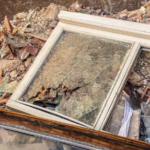
How to Extend the Life of Your Window Glass After a Foggy Window Repair
January 7, 2025
Is Broken Glass Dangerous? Why Timely Replacement Matters
January 13, 2025A foggy window can be a frustrating issue for homeowners. Not only does it obscure your view, but it can also affect your home’s energy efficiency. If you’ve noticed that your windows have become foggy, you may be wondering whether it can be repaired or if a full replacement is necessary. In this guide, we’ll explore the causes of foggy windows, how to assess whether foggy window repair is possible, and when it’s time to replace the window altogether.
What Causes Foggy Windows?
Foggy windows typically occur when moisture gets trapped between the panes of a double or triple-pane window. This moisture can be caused by several factors, including:
- Seal Failure: Most modern windows have two or more layers of glass with a sealed air space between them. Over time, the sealant that holds the glass in place can deteriorate or break, allowing moisture to seep in and form condensation between the panes.
- Temperature Fluctuations: Windows are subject to constant temperature changes due to external weather conditions and indoor heating or cooling. This can cause the seals to weaken over time, leading to condensation buildup.
- Old or Poor-Quality Windows: Older windows or those made from lower-quality materials are more prone to seal failure, which can result in fogging.
- High Humidity Levels: In areas with high humidity, moisture is more likely to get trapped between the panes of a window, leading to fogging.
- Poor Installation: If a window was not installed correctly, it could affect the performance of the seals, allowing moisture to accumulate.
Can a Foggy Window Be Repaired?
In many cases, foggy windows can be repaired, but whether or not this is possible depends on the severity of the fogging and the cause of the issue. Here are some considerations to help you determine if foggy window repair is the best option:
1. Check the Type of Window
The most common type of window that experiences fogging is a double or triple-pane insulated window. These windows are designed with a sealed airspace between the panes to provide better insulation and energy efficiency. If the fogging is confined to this space, it may be a sign of a broken seal. Fortunately, in many cases, a broken seal can be repaired without replacing the entire window.
On the other hand, single-pane windows don’t have an air gap, and the condensation you see on the glass is likely due to external moisture buildup, which can often be wiped away.
2. Inspect the Severity of the Fogging
If the fog is limited to a small section of the window and doesn’t affect the overall visibility too much, it might be possible to repair the window. However, if the entire window is fogged up, or if the fog has persisted for an extended period, this could indicate a more severe issue, such as seal failure or deterioration of the insulating gas between the panes.
If the fogging is only on the surface of the window (external condensation), it is usually easier to clean or remove. But if it’s between the panes of glass, repair options become more limited.
3. Consider the Age of the Window
The age of your window is another factor to consider when deciding whether repair is possible. Windows that are several decades old or have outdated seal technology are more likely to have experienced significant deterioration, making repair more challenging. In such cases, it may be more cost-effective to replace the window entirely.
4. Evaluate the Extent of the Damage to the Seals
If the seal has failed but is still intact around the edges, it may be possible to repair the foggy window by resealing it or applying a special defogging treatment. In some cases, the fogging can be cleared with a defogging service, which involves drilling small holes in the window to remove the moisture and then resealing the window.
However, if the seal has completely broken down and is no longer effective, it may be necessary to replace the entire window unit.
5. Check for Other Issues
Sometimes, foggy windows are a symptom of other problems, such as poor insulation, water leaks, or structural damage to the window frame. In these cases, repair may not be enough to address the root cause, and full window replacement may be necessary.
When Should You Consider Full Window Replacement?
There are situations when foggy window repair just isn’t enough, and full window replacement becomes the better option. Here are some scenarios where it might be time to replace your foggy windows:
1. The Window Seal is Beyond Repair
If the window seal has completely failed and there is no feasible way to repair it, you’ll likely need to replace the window. An entirely broken seal lets in air and moisture, and the window will no longer provide proper insulation, which can negatively affect your home’s energy efficiency.
2. The Window is Too Old
If the window is over 15–20 years old, it may be time for an upgrade. Older windows, especially those with single-pane glass or outdated technology, are more prone to fogging and other issues. In this case, investing in a new, energy-efficient window can save you money on heating and cooling bills in the long run.
3. The Fogging is Permanent
In cases where the fogging has persisted for a long period and no amount of cleaning or defogging can restore the clarity, it might be time to replace the window. Permanent fogging is usually a sign of extensive damage that cannot be reversed.
4. The Window Frame is Damaged
If the frame of your window has suffered damage, such as rot, warping, or deterioration, it may no longer be structurally sound. In this case, simply repairing the glass will not address the underlying issue, and you’ll need to replace both the glass and the frame.
5. You Want to Improve Energy Efficiency
Old windows, especially those with broken seals, tend to be much less energy-efficient than newer models. If you are looking to lower your energy bills and enhance the comfort of your home, replacing your foggy window with a more energy-efficient option may be a smart investment.
Window Fog Repair vs. Replacement: Pros and Cons
To help you make an informed decision, here’s a quick overview of the pros and cons of foggy window repair versus full replacement:
Foggy Window Repair:
- Pros:
- Cost-effective for minor issues.
- Faster process compared to full replacement.
- Can restore functionality if the damage is minimal.
- Cons:
- Only works for certain types of damage (e.g., broken seals).
- May not be effective in the long term if the window is old or severely damaged.
- Not a permanent solution if the underlying problem persists.
Window Replacement:
- Pros:
- Provides a long-term solution for energy efficiency and aesthetics.
- Modern windows are more durable and energy-efficient.
- Increases the value of your home.
- Cons:
- Higher upfront cost.
- Time-consuming installation process.
Deciding whether to repair or replace a foggy window depends on the severity of the damage, the age of the window, and your long-term goals. If the fogging is caused by a broken seal and is limited to one or two windows, repair may be a viable option. However, if the window is old, the seal is irreparably damaged, or the fogging is permanent, replacement may be the better choice.
Consulting with a professional window service provider can help you determine the best course of action for your foggy windows, whether it’s repair or replacement. Keep in mind that addressing foggy windows promptly can help maintain your home’s energy efficiency, comfort, and curb appeal.





